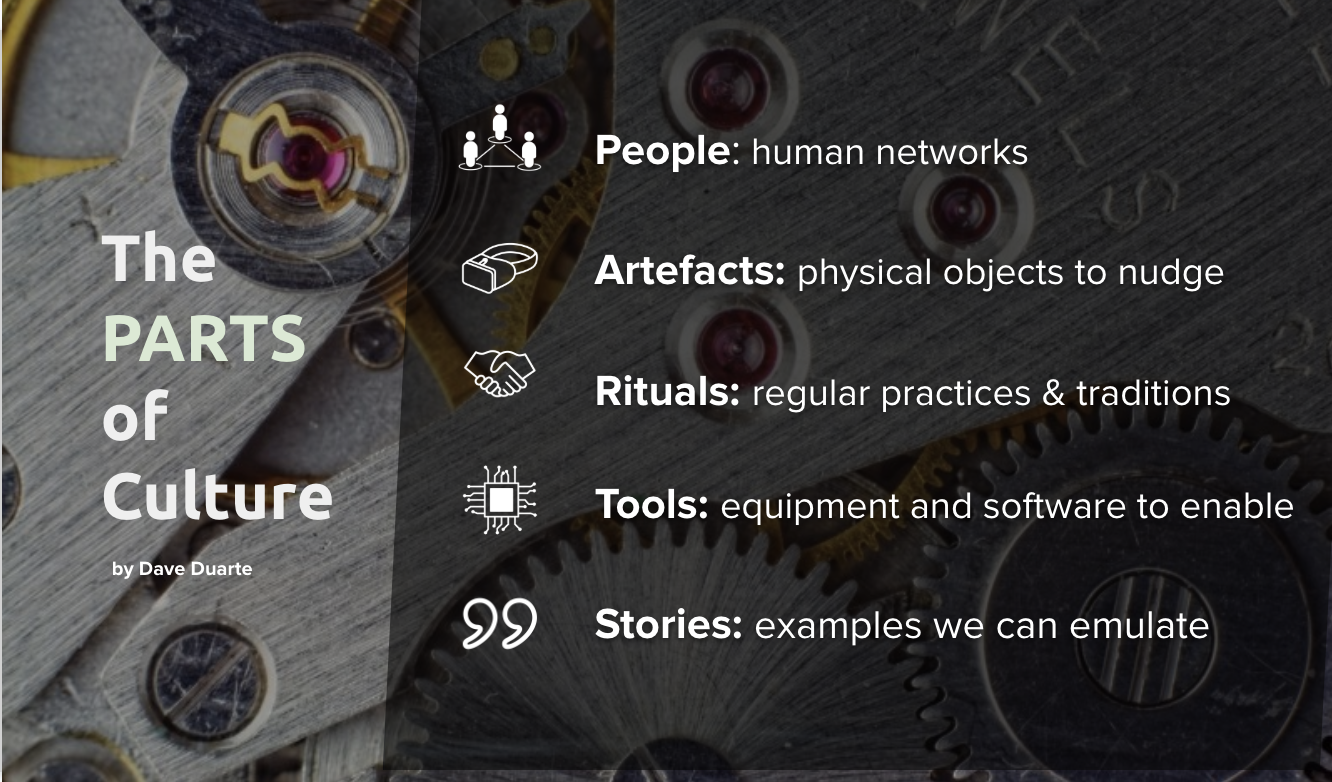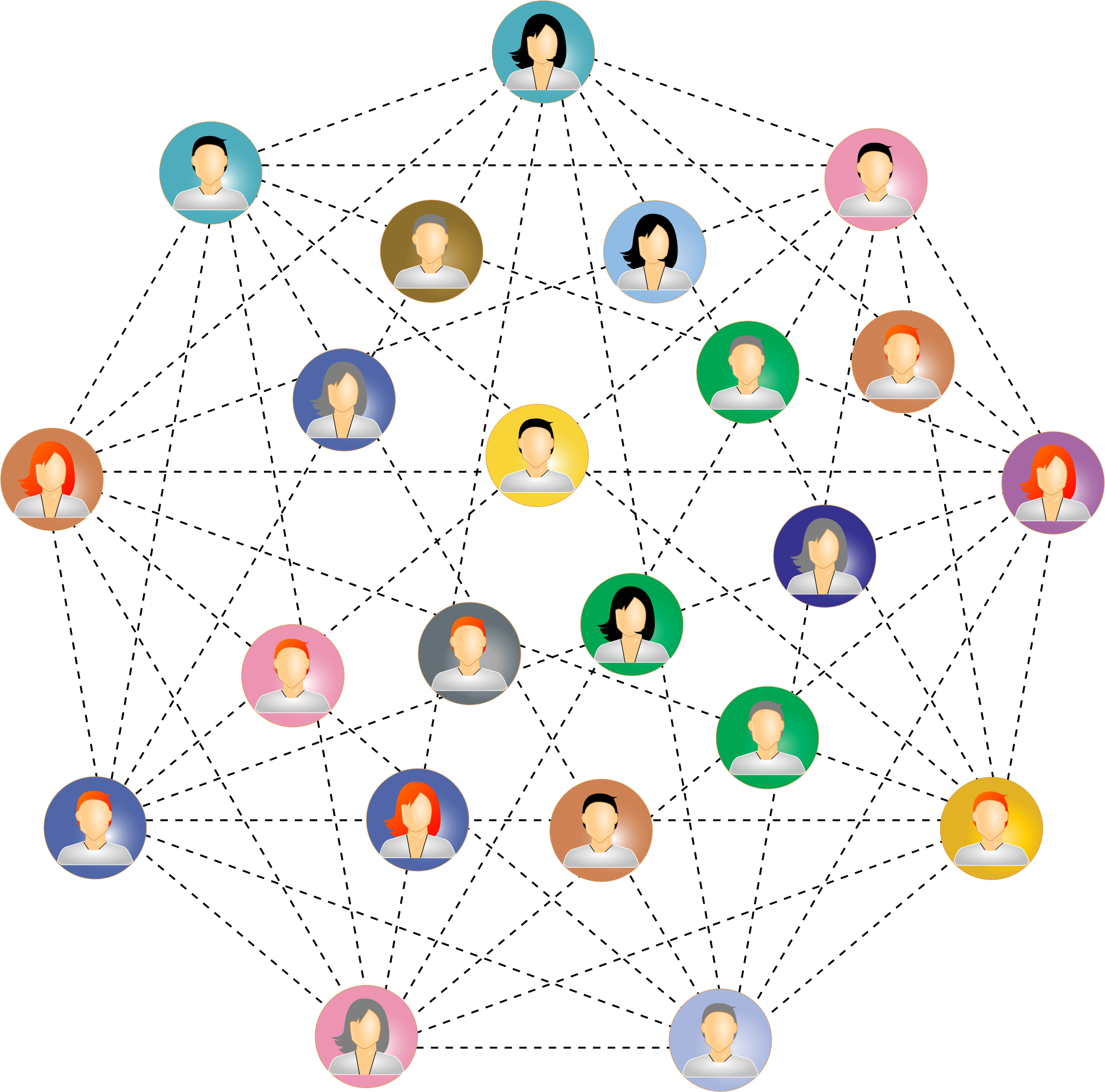PARTS: The 5 working parts of company culture
By Dave Duarte
Culture is the hidden force that shapes our decision-making day to day, what we value, and how we get things done. And yet culture isn’t something that can be set in place, it is emergent and adapts.
The PARTS of Culture provides an memorable framework to work with when aiming to influence culture. It stands for People, Artefacts, Rituals, Tools, and Stories.
A bit of background
When we launched the OgilvyDMA in 2010, Rob Hill and Gavin Levinsohn said our primary objective was to help "geekify" the Ogilvy Cape Town culture. Now, "Changing Culture" sounds all well and good, but when it came to it I had no idea where to start. I turned to sociological theory on culture for clarity, and out of that developed PARTS as a way to make the key concepts memorable and strategically actionable.
Here’s more details on each of these aspects, and how we applied them with remarkable success at Ogilvy.
People: gain the support of a few well connected people, and help them recruit others
Too many companies make the mistake of trying to change the whole company at once. You’re more likely to gain traction incubating culture among a group of influential people who have provide reach and access to the rest of the organisation.
Behaviours spread from person to person (Christakis, 2007). So it's important to work with a small group of people initially to make sure the cultural change is understood and adapted.
The key players in a social network are your Experts, Influencers, Gatekeepers, and Connectors. Each are important in their own ways, and you need to gain their support for any culture change initiative. These people need to have a high frequency of contact with the cultural change process an practice. They are going to be the ones that set the example and distribute the culture to the rest of the organisation. As Derek Sivers famously put it "new followers don't follow the leader, they follow the other followers."
At Ogilvy, the most influential people throughout the agency were invited to our first Ogilvy Digital Marketing Academy, and no expense was spared in ensuring a transformative learning experience that created group buy-in and connection.
Artefacts: make the culture change public and visible
Our physical environment and the objects in it form the stage on which your staff perform. Are you setting them up for great performances, giving them the cues and props they need? Art, Awards, and artefacts of belonging (like lapel pins, t-shirts, certificates) all serve to communicate cultural values.
Open Knowledge Foundation, "OPEN" lapel pin, by Brian Glanz
Amazon, for example, reminds people of their value of frugality through the use of door-desks throughout the company.
Ogilvy encouraged more a more digitally savvy culture by making the latest gadgets available to staff through Ogilvy Labs. There are screens live-streaming social data from clients, there are interactive demos of the latest in sensory technology around the office, and there are framed certificates displayed for people who complete digital training. Other artefacts could include the kinds of awards that are valued, for example, displaying Cannes Lions, or Bookmark Awards.
Rituals: Go from a moment to a movement
The things a company does regularly become a signal of their culture. The rituals can be small or large, everything from how you on-board staff to how you handle daily meetings.
The key thing when you want to introduce a ritual is to do it consistently and repeatedly. It takes time for new behaviours to take root. Your company values aren’t just things that you just write down and forget about, they should be reflected in what behaviours you reward. In who you hire, promote and let go. These create behavioural norms that become embedded in your company culture.
For example, Ogilvy hosts a regular “How-To Friday” session where people who have done something extraordinary share how they did it. This signals the company’s long-term commitment to hands-on innovation.
Tools: give people the resources to create change
How do you equip your people to do their work in a way that reflects company culture? You can't expect change if you don't enable it. Language, skills, technology, equipment, and other resources are major enablers of change.
The most fundamental tool for culture-shaping is language. When you want to shift culture, equip people with new ways to talk about what they do.
A key part of the Ogilvy Digital Marketing Academy's success was, and is, giving people the language to speak about digital. Concepts like Impressions, Reach, Landing Pages, and Programmatic become more useful when we have the words to talk about them.
Story: don't just tell people about the change, show them what others are doing
Stories are the way that people naturally encode and share complex social information. There are two ways a company can bring their story to life: storytelling and storymaking.
Storytelling is about finding examples of good cultural practice and crafting stories around those actions so that it is easier for others to understand what to do, and to emulate the success of the cultural heroes you celebrate.
Storymaking is about kickstarting this process. It’s not just about what you celebrate, but also how you take action. It is about taking decisive action to establish cultural precedence.
At Ogilvy, stories were created by investing more heavily in case-studies involving digital integration, such as Be The Coach (which went on to become the most awarded campaign of the year - winning international plaudits including four Gold Lions at Cannes)
Stories are like software for the mind. They help us understand cause and effect, and can have a transformative effect on what we see as possible and expected.
The results of the first application of our PARTS model can best be summed up by Ogilvy Cape Town's Managing Director, Gavin Levinson
“What’s the best thing that’s happened in the Ogilvy ‘family’ over the past three years? While there are many highlights and accolades within and across all of Ogilvy’s companies, I would undoubtably say that the ODMA has and continues to be our finest hour.”
Treeshake offers story-making workshops and talks on culture change, leading innovation, and values-driven leadership.





Dave Duarte, founder of Treeshake, is passionate about community engagement as a driver of value. As social marketer, speaker, facilitator and advisor, his warm and engaging style makes the future easy to engage with. Dave brings over a decade of facilitation experience to his work at Treeshake. He has founded several businesses, and served in leadership positions in media, academia, and non-profits.